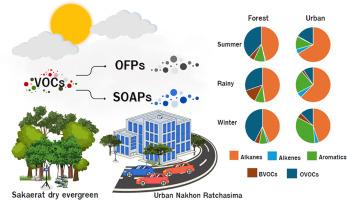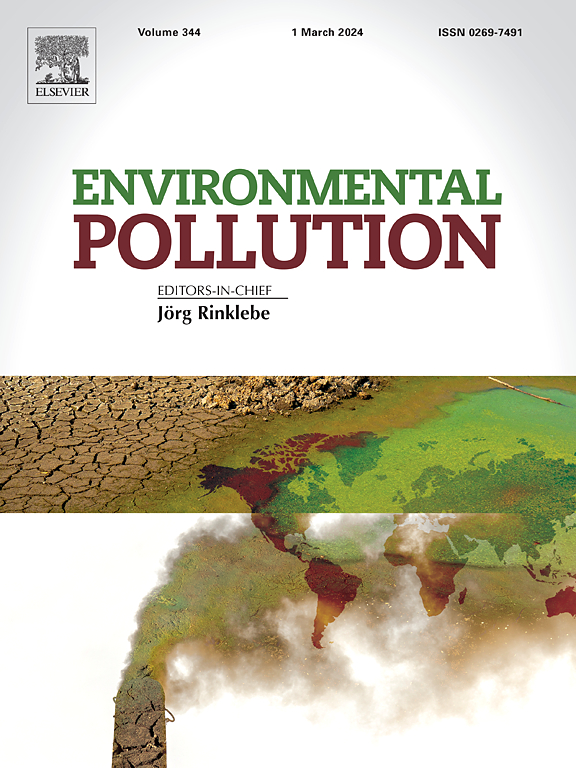Seasonal volatile organic compound dynamics in urban and forest environments in Thailand: Implications for air quality and secondary pollutants
IF 7.6
2区 环境科学与生态学
Q1 ENVIRONMENTAL SCIENCES
引用次数: 0
Abstract
Volatile organic compounds (VOCs) notably influence air quality, climate and secondary pollutant formation, particularly regions in where urban emissions interact with natural biogenic sources at the interface of urban and natural ecosystems. This study examined the VOC profiles in the Sakaerat dry evergreen forest and the urban area of Nakhon Ratchasima, Thailand, throughout 2023, focusing on seasonal and spatial variations in biogenic and anthropogenic VOCs (BVOCs and AVOCs, respectively). Hydrocarbons, mainly alkanes, dominated VOC compositions, contributing 43.74–47.44% of the total detected VOCs in the forest and 44.89–66.35% in urban areas. Aromatic hydrocarbons accounted for 7.63–10.36% in the forest but increased to 11.80–34.56% in urban areas, peaking in winter. BVOCs, such as isoprene and D-limonene, were more prevalent in the forest (4.41–12.67%) than in urban areas (0.75–4.65%). Meanwhile, oxygenated VOCs (OVOCs) displayed considerable seasonal contributions, ranging from 30.24 to 42.62% in the forest to 9.14–16.78% in urban areas. Seasonal trends exhibited elevated BVOC emissions in the forest during the rainy season and higher AVOC levels in urban areas during summer. Negative and positive correlations with relative humidity were observed in the forest and in urban areas, respectively. Diurnal variations revealed that isoprene emissions in the forest increased with rising daytime temperatures, while VOC concentrations in urban areas showed little to no fluctuation throughout the day. Temperature, humidity and atmospheric transport were key drivers shaping VOC dynamics, highlighting distinct patterns of biogenic and anthropogenic emissions. This study highlights the importance of long-term VOC monitoring to evaluate the environmental impacts of urbanisation on natural ecosystems. These findings provide valuable insights to support air quality management and the mitigation of pollution at the interface of urban and natural environments.


泰国城市和森林环境中的季节性挥发性有机化合物动态:对空气质量和二次污染物的影响
挥发性有机化合物显著影响空气质量、气候和二次污染物的形成,特别是在城市排放与城市和自然生态系统界面上的自然生物源相互作用的区域。研究了2023年泰国那空叻府(Nakhon Ratchasima) Sakaerat干常绿森林和城市地区的挥发性有机化合物(VOC)特征,重点研究了生物源和人为源挥发性有机化合物(BVOCs和AVOCs)的季节和空间变化。挥发性有机化合物以烷烃为主,占森林总挥发性有机化合物的43.74 ~ 47.44%,城市总挥发性有机化合物的44.89 ~ 66.35%。林区芳烃含量为7.63 ~ 10.36%,城区为11.80 ~ 34.56%,冬季达到峰值。异戊二烯和d -柠檬烯等BVOCs在森林地区的分布(4.41 ~ 12.67%)高于城市地区(0.75 ~ 4.65%)。同时,含氧VOCs (OVOCs)的季节性贡献较大,森林为30.24 ~ 42.62%,城市为9.14 ~ 16.78%。季节性趋势表现为雨季森林中BVOC排放量升高,夏季城市地区AVOC水平升高。在森林和城市地区分别与相对湿度呈负相关和正相关。日变化表明,森林中的异戊二烯排放量随着白天温度的升高而增加,而城市地区的VOC浓度全天几乎没有波动。温度、湿度和大气运输是形成VOC动态的关键驱动因素,突出了生物和人为排放的不同模式。本研究强调了长期VOC监测对评估城市化对自然生态系统的环境影响的重要性。这些发现为支持空气质量管理和减轻城市与自然环境交界的污染提供了宝贵的见解。
本文章由计算机程序翻译,如有差异,请以英文原文为准。
求助全文
约1分钟内获得全文
求助全文
来源期刊

Environmental Pollution
环境科学-环境科学
CiteScore
16.00
自引率
6.70%
发文量
2082
审稿时长
2.9 months
期刊介绍:
Environmental Pollution is an international peer-reviewed journal that publishes high-quality research papers and review articles covering all aspects of environmental pollution and its impacts on ecosystems and human health.
Subject areas include, but are not limited to:
• Sources and occurrences of pollutants that are clearly defined and measured in environmental compartments, food and food-related items, and human bodies;
• Interlinks between contaminant exposure and biological, ecological, and human health effects, including those of climate change;
• Contaminants of emerging concerns (including but not limited to antibiotic resistant microorganisms or genes, microplastics/nanoplastics, electronic wastes, light, and noise) and/or their biological, ecological, or human health effects;
• Laboratory and field studies on the remediation/mitigation of environmental pollution via new techniques and with clear links to biological, ecological, or human health effects;
• Modeling of pollution processes, patterns, or trends that is of clear environmental and/or human health interest;
• New techniques that measure and examine environmental occurrences, transport, behavior, and effects of pollutants within the environment or the laboratory, provided that they can be clearly used to address problems within regional or global environmental compartments.
 求助内容:
求助内容: 应助结果提醒方式:
应助结果提醒方式:


